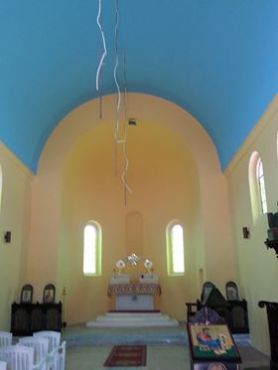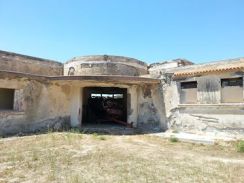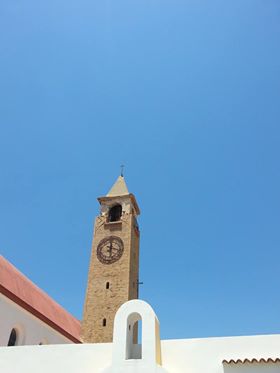ITALIAN ISLAND OF RHODES
The dodecanese island of ITALIAN RHODES was called in italian: Rodi italiana. It lasted under Italy's control from 1911 until 1943 and officially remained italian until the WW2 "Peace Treaty" of February 1947.
In those 36 years the Italian presence left in the island an heritage in many areas, from architecture to social development. For example, the Italian Dodecanese islands were the only areas of actual Greece that did not experience the "exchange of populations" (between Greece and Turkey): the small Turkish community remained in the Rhodes island until our days, thanks to the Italian government (that promoted a friendly relationship between the local greek & turkish communities).
Photo of Italian village "Campochiaro" in 1936 (if interested, read also in italian and with video:https://www.bibliotecacivica.rovereto.tn.it/Eventi-e-attivita/ARCHIVIO-EVENTI/Il-recupero-del-Villaggio-di-Campochiaro-sull-isola-di-Rodi)
BRIEF HISTORY
During the Italo-Turkish War started in 1911 the Kingdom of Italy occupied the island of Rodi (called Rhodes in English) & the Dodecanese islands in the Aegean sea (For only the city of Rodi, please read my https://dadfeatured.blogspot.com/2019/01/rodi-italiana.html).
In the 1930s Mussolini embarked on a program of Italianization, hoping to make the island od Rhodes a modern transportation hub that would serve as a focal point for the spread of Italian culture in Greece and Levant.
The 1912 landing of Italian troops in Rhodes island
The main castle of the Knights of St. John was also rebuilt. The concrete-dominated Fascist architectural style integrated significantly with the islands' picturesque scenery (and also reminded the inhabitants of Italian rule), but has consequently been largely demolished or remodeled, apart from the famous example of the Leros town of Lakki, which remains a prime example of this architecture.
From 1923 to 1936 governor Mario Lago was able to integrate the Greek, Turkish and Ladino Jewish communities of the island of Rhodes with the Italian colonists, obtaining a so called "Golden Period" in the Italian Dodecanese with the economy and the society enjoying huge developments and harmony (http://www.dodecaneso.org/2336a.htm The "golden years" of governor Lago (in Italian).
From 1936 to 1940 Cesare Maria De Vecchi acted as governor of the Italian Aegean Islands promoting the official use of the Italian language and favoring a process of italianization, interrupted by the beginning of WWII (http://books.google.com/books?id=fJ3gVGqB1uQC&pg=PA436&lpg=PA436&dq=de+vecchi+dodecanese+italian+language&source=web&ots=gIgR81ZYv9&sig=2gIp1imYJUVYZH6iSY9gfq0KXck#PPA436,M1. De Vecchi even wanted to include the Italian Dodecanese (called also "Isole Egee italiane") in the project of Mussolini's Greater Italia.
In the 1936 Italian census of the Dodecanese islands, the total population was 129,135, of which 7,015 were Italians. Nearly 80% of the Italian colonists lived in the island of Rhodes, where there was an important Italian naval base. Aproximately 40,000 Italian soldiers and sailors were on military duty in the Dodecanese islands in 1940.
During World War II, Italy joined the Axis Powers, and used the Dodecanese as a naval staging area for its invasion of Crete in 1940. After the Armistice in September 1943, the islands briefly became a battleground between the Nazi Germans and the Italians. The Germans prevailed and although they were driven out of mainland Greece in 1944, the Dodecanese remained occupied until the end of the war in 1945, during which time nearly the entire Jewish population of 6,000 was deported and killed. Only 1200 of these Ladino speaking Jews survived, thanks to their lucky escape to the nearby coast of Turkey with some help from the Italian colonists of Rhodes.
There were 3 periods of the Italian presence in Rhodes: the first after the occupation in 1911 and until the treaty with the official annexation & Turkish renounce to the Dodecanese islands.; the second under Mario Lago rule and the third under the one of De Vecchi until the beginning of ww2.
Three years later (1943), after the fall of Mussolini and the capitulation of Badolio, the Germans would take over the islands ending formally the Italian presence & rule on the islands after more than thirty years.
Actually the citadel of Rhodes city is a UNESCO World Heritage Site, thanks in great part to the large-scale restoration work done by the Italian authorities in what was "Rodi italiana" from 1912 to 1943.
The Rhodes government center showing the Italian flag in 1919
During the Italo-Turkish War started in 1911 the Kingdom of Italy occupied the island of Rodi (called Rhodes in English) & the Dodecanese islands in the Aegean sea (For only the city of Rodi, please read my https://dadfeatured.blogspot.com/2019/01/rodi-italiana.html).
PALAZZO DEL GOVERNO (today the offices of the "Prefecture of the Dodecanese"), built by architect Di Fausto in 1927
With the Treaty of Lausanne in 1923 the Dodecanese was formally annexed by Italy, as the ''Possedimenti Italiani dell'Egeo''.
In the 1930s Mussolini embarked on a program of Italianization, hoping to make the island od Rhodes a modern transportation hub that would serve as a focal point for the spread of Italian culture in Greece and Levant.
The 1912 landing of Italian troops in Rhodes island
The main castle of the Knights of St. John was also rebuilt. The concrete-dominated Fascist architectural style integrated significantly with the islands' picturesque scenery (and also reminded the inhabitants of Italian rule), but has consequently been largely demolished or remodeled, apart from the famous example of the Leros town of Lakki, which remains a prime example of this architecture.
From 1923 to 1936 governor Mario Lago was able to integrate the Greek, Turkish and Ladino Jewish communities of the island of Rhodes with the Italian colonists, obtaining a so called "Golden Period" in the Italian Dodecanese with the economy and the society enjoying huge developments and harmony (http://www.dodecaneso.org/2336a.htm The "golden years" of governor Lago (in Italian).
From 1936 to 1940 Cesare Maria De Vecchi acted as governor of the Italian Aegean Islands promoting the official use of the Italian language and favoring a process of italianization, interrupted by the beginning of WWII (http://books.google.com/books?id=fJ3gVGqB1uQC&pg=PA436&lpg=PA436&dq=de+vecchi+dodecanese+italian+language&source=web&ots=gIgR81ZYv9&sig=2gIp1imYJUVYZH6iSY9gfq0KXck#PPA436,M1. De Vecchi even wanted to include the Italian Dodecanese (called also "Isole Egee italiane") in the project of Mussolini's Greater Italia.
In the 1936 Italian census of the Dodecanese islands, the total population was 129,135, of which 7,015 were Italians. Nearly 80% of the Italian colonists lived in the island of Rhodes, where there was an important Italian naval base. Aproximately 40,000 Italian soldiers and sailors were on military duty in the Dodecanese islands in 1940.
During World War II, Italy joined the Axis Powers, and used the Dodecanese as a naval staging area for its invasion of Crete in 1940. After the Armistice in September 1943, the islands briefly became a battleground between the Nazi Germans and the Italians. The Germans prevailed and although they were driven out of mainland Greece in 1944, the Dodecanese remained occupied until the end of the war in 1945, during which time nearly the entire Jewish population of 6,000 was deported and killed. Only 1200 of these Ladino speaking Jews survived, thanks to their lucky escape to the nearby coast of Turkey with some help from the Italian colonists of Rhodes.
There were 3 periods of the Italian presence in Rhodes: the first after the occupation in 1911 and until the treaty with the official annexation & Turkish renounce to the Dodecanese islands.; the second under Mario Lago rule and the third under the one of De Vecchi until the beginning of ww2.
Three years later (1943), after the fall of Mussolini and the capitulation of Badolio, the Germans would take over the islands ending formally the Italian presence & rule on the islands after more than thirty years.
Actually the citadel of Rhodes city is a UNESCO World Heritage Site, thanks in great part to the large-scale restoration work done by the Italian authorities in what was "Rodi italiana" from 1912 to 1943.
The Rhodes government center showing the Italian flag in 1919
THE ISLAND OF RHODES HISTORICAL ITALIAN SITES
The city of Rodi is located to the eastern side of the island of Rodi. It is the most important historical site of the island, but there are other places with importance (someone related to Italy's occupation of the island).
Indeed historical sites on the island of Rhodes (outside of Rhodes city) include the Acropolis of Lindos, the Acropolis of Rhodes (with the Temple of Pythian Apollo and an ancient theatre and stadium), ancient Ialysos, ancient Kamiros, the ruins of the castle of Monolithos, the castle of Kritinia, St. Catherine Hospice and Rhodes Footbridge. But there are a few related to the Italian rule of the island during the first half of the XX cenrtury.
Outside Rodi city, the locality with the best remains of the Italian presence & architecture is Eleousa
(founded by the Italian government with the name "Campochiaro"). It is noteworthy to pinpoint that in the island were created the following "centri rurali" (farm villages) for Italian colonists: “Peveragno Rodio” (1929), “Campochiaro” (1935-36), “San Marco” (1936) and “Savona” (1936-38) -from 1938 called “San Benedetto”.
Peveragno Rodio (actual Epàno Kàlamon)
The center was named Peveragno Rodio in honor of the Governor of the Aegean Mario Lago, a native of the homonymous town in the province of Cuneo. It was elevated to a municipality on August 8, 1930. Obviously, agricultural production focused on Mediterranean crops: olive trees, vines and orchards, but there was also a livestock sector. At first 8,000 olive trees, 7,000 fruit trees and 130,000 vines were planted and 110 cattle and 800 sheep were brought in while a series of modern agro-industrial plants allowed the processing on site of the production that was mostly exported or which, as dairy products, immediately found an outlet on the market of nearby Rhodes.
Hundreds of workers with their families from Italy were brought in, excluding the involvement of Greek peasants who were present only as casual or wage workers. The settlers who were transferred there came from several Italian regions and above all from the province of Pavia: depending on the origin they were directed towards specific activities in relation to the experience gained in the places of origin: the people of Pavia took care of herbaceous and forage crops, the ones from Romagna of orchards and pastoralice those from Salerno. On balance it cannot be said that Peveragno Rodio was a success, nor with the short time in which the Italians worked it could be otherwise: the area was too vast to be quickly cultivated and fruitful, and was needed a lot of labor.
Peveragno Rodio was abandoned after WW2, but the village did not die. The most characteristic structures, including the lictorian-style buildings and the church have been transformed into an Greek army base: the area is forbidden to visit and the buildings cannot even be photographed but are still all "in service activities" to put it in military words. Even the work done by Italian farmers was not wasted. The land had already been cleared and the plants planted had grown in the meantime: the Italian company was replaced by Greek farmers, who treasured what had been left by the italian colonists.
Campochiaro (actual Eleousa)
The best village was Campochiaro, where there was also the so called "Casa di Mussolini" (Mussolini House). The house was built by governor Ceasre De Vecchi for Mussolini as his retirement home, though he never visited, and it was abandoned in the mid 1940's. Cesare De Vecchi (who ruled the island from 1936 to 1940), was one of the Quadrumvirs in Mussolini’s central ruling tetrarchy and strongly promoted the "italianization" of the island of Rodi in architecture, language, customs, etc...
Actually the house is in bad conditions because of lack of maintenance since the 1950s, but in another "centro rurale" -named "San Marco"- the situation is different.
San Marco (actual Kattavia)
In the southernmost part of the island of Rhodes, in the still almost uninhabited plain of Kattavia, there is the rural village San Marco (created circa 1936), with a clear Italian rationalist architectural matrix, with the bell tower that refers - in albeit simplified architectural terms - to the well-known one of the Serenissima Venezia, with the church dedicated to the aforementioned Saint and an entire area occupied by the elementary school classrooms (in a photo you can still see a few letters of the word "elementary"), for the children of the 200 Italian settlers who emigrated there, mostly from the regions of north east Italy (mainly Veneto and Romagna).
In "San Marco Villaggio di Rodi", until about 1942, about two hundred people lived there and worked hard there, even without the hoped-for results in agro-economic terms, since the surrounding land (obtained from a previous reclamation work of a large area stagnant) were excessively acidic/saline. The silk production was also raised and improved. In the same plain of Kattavia there was also a landing strip for Italian military aircraft, now almost indistinguishable.
After decades of oblivion and abandonment (what increasingly characterizes all the valuable built in the Italian Dodecanese of the 20-30s), for about two years private subjects have proudly restored the central body of the village (with cloister and colonnade), the church and partly the bell tower (the clock mechanisms have been stolen from time immemorial), opening a bar/restaurant there.
Photos of the restored San Marco village
.




.jpg)













